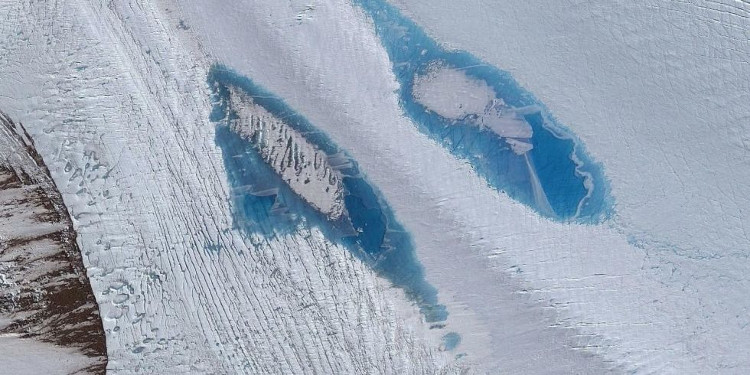Thousands of these green streaks are appearing in Antarctica, and that's extremely bad news
These blue streaks can have serious consequences for the Antarctic region in particular and the Earth in general.
Recently, the East Antarctic map is showing many strange blue streaks as shown below.

Strange blue markings appear in Antarctica.
These are the lakes that are appearing in Antarctica, with numbers up to thousands. And according to experts, they are extremely worried.
Previously, this phenomenon had happened in Greenland. The ice in this country suddenly melted, causing Greenland to lose thousands of tons of ice in the period 2011-2013. And the reason is said to be because of these lakes themselves.
The team in the UK, after analyzing images from satellites, realized for the first time that between 2000 and 2013, Antarctica had more than 8,000 lakes . Among these, there are lakes formed by melting ice, and they are at risk of causing the entire ice shelf here to be unstable.
The problem here is that experts have so far assumed that the East Antarctic region is immune to the effects of climate change. Therefore, they only focused on the area of the Antarctic Peninsula - the extreme North of Antarctica - where there are signs of climate warming.

Experts have long assumed that the East Antarctic region is immune to the effects of climate change.
Therefore, knowledge of the current East Antarctic is quite limited, and experts fear that this will make it difficult to overcome and predict the consequences of these lakes.
According to Stewart Jamieson, an expert from Durham University (UK): "East Antarctica is a region that is supposed to be stable. The changes here are negligible, and the climate is extremely cold, so these are The first lake was identified ".
He explained, rising temperatures in the summer will cause these lakes to form on the surface of ice. But such lakes cannot last long. They can be frozen back - and that's if you're lucky.
Otherwise, lake water may flow back into the icebergs below, or flow into glaciers and escape to the ocean. If this is the case, the ice will gradually erode. The ice structure weakens, accelerating the melting process, just like in Greenland's case.
Climate change is the culprit
But why did suddenly the East Antarctic area appear so many lakes in the last few years? You probably guessed it - it's because of climate change.

Due to climate change, there are many large lakes in the East Antarctic.
According to the research team, during the 13-year study period, the summer of 2012 - 2013 is the hottest summer, of which there are 37 days "positive" temperature - ie above 0 degrees C. In this range, new lakes formed 36% more than usual.
Jamieson said : "We found that the appearance of these lakes is directly related to air temperature. Not only that, both the number of lakes, the area of the lake, the depth of the lake is no exception. ".
Now experts are not "confident" enough to claim that the East Antarctic is beginning to be destroyed. However, in July 2016, the world recorded a record hot summer, along with the sea level rising rapidly with unprecedented high speed, ie more and more lakes appeared.
According to Jamieson: "The lake area may not be large enough to influence too much now, but if the climate continues to change in the future, we can only watch the number and size of the lake increase." .
The study is published in Geophysical Research Letters.
- See thousands of sparkling star streaks in the sky
- Video: Light streaks like alien objects appearing in the sky of America
- The US coast is 'dyed' green because of thousands of jellyfish
- The warming Earth makes Antarctica more and more green
- Green light streaks appear between thunderstorms in Australia
- Hundreds of thousands of green jellyfish stranded in Australia
- Rare phenomenon: Thousands of
- Normal jobs become extremely difficult in Antarctica
- Mysterious cone light streaks in the sky of America
- Discovered a rare species of penguin in Antarctica
- For thousands of years of green forever: Change living behavior
- Summary of the best news from 01/01/2017
 Is the magnetic North Pole shift dangerous to humanity?
Is the magnetic North Pole shift dangerous to humanity? Washington legalizes the recycling of human bodies into fertilizer
Washington legalizes the recycling of human bodies into fertilizer Lightning stone - the mysterious guest
Lightning stone - the mysterious guest Stunned by the mysterious sunset, strange appearance
Stunned by the mysterious sunset, strange appearance